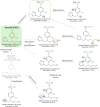Genomic, Transcriptomic and Suspect/Non-Target Screening Analyses Reveal the Role of CYP450s in the Degradation of Imazalil and Delineate Its Transformation Pathway by Cladosporium herbarum
- PMID: 39972684
- PMCID: PMC11839493
- DOI: 10.1111/1751-7915.70102
Genomic, Transcriptomic and Suspect/Non-Target Screening Analyses Reveal the Role of CYP450s in the Degradation of Imazalil and Delineate Its Transformation Pathway by Cladosporium herbarum
Abstract
Imazalil (IMZ), a major surface water contaminant characterised by high environmental recalcitrance and toxicity, is used in fruit-packaging plants to control fungal infestations during storage. This leads to the production of wastewaters which should be treated on site before their environmental release. We previously isolated a Cladosporium herbarum strain, the first microorganism that could degrade IMZ. Here we describe the genetic network utilised by the fungus to degrade IMZ and its detailed transformation. Genomic and transcriptomic analysis of C. herbarum pointed to the involvement of strongly upregulated CYP450s in IMZ degradation, as further verified by cessation of its biodegradation by CYP450 inhibitors. LC-QTOF-HRMS analysis and suspect/non-target screening identified nine transformation products (TPs) of IMZ. IMZ biotransformation mainly proceeded through O-dealkylation, while other less important paths, most probably controlled by upregulated oxidases, were operative involving successive hydroxylation reactions. These lead to the formation of TPs like IMZ_313 and IMZ_331, with the former being further transformed through imidazole ring scission to IMZ_288, a TP reported for the first time. We provide first evidence for the transformation mechanism of IMZ by C. herbarum and the potential genes/enzymes involved, paving the way for the use of C. herbarum in the biodepuration of agro-industrial effluents.
Keywords: Cladosporium herbarum; CYP450 monoxygenases; Imazalil; O‐dealkylation; transformation products.
© 2025 The Author(s). Microbial Biotechnology published by John Wiley & Sons Ltd.
Conflict of interest statement
The authors declare no conflicts of interest.
Figures






Similar articles
-
Isolation, characterization and industrial application of a Cladosporium herbarum fungal strain able to degrade the fungicide imazalil.Environ Pollut. 2022 May 15;301:119030. doi: 10.1016/j.envpol.2022.119030. Epub 2022 Feb 18. Environ Pollut. 2022. PMID: 35189300
-
Degradation alternatives for a commercial fungicide in water: biological, photo-Fenton, and coupled biological photo-Fenton processes.Environ Sci Pollut Res Int. 2017 Nov;24(33):25634-25644. doi: 10.1007/s11356-016-7602-4. Epub 2016 Sep 17. Environ Sci Pollut Res Int. 2017. PMID: 27640058
-
PdCYP51B, a new putative sterol 14α-demethylase gene of Penicillium digitatum involved in resistance to imazalil and other fungicides inhibiting ergosterol synthesis.Appl Microbiol Biotechnol. 2011 Aug;91(4):1107-19. doi: 10.1007/s00253-011-3355-7. Epub 2011 Jun 3. Appl Microbiol Biotechnol. 2011. PMID: 21637936
-
Potential for bioremediation of agro-industrial effluents with high loads of pesticides by selected fungi.Biodegradation. 2011 Feb;22(1):215-28. doi: 10.1007/s10532-010-9389-1. Epub 2010 Jul 16. Biodegradation. 2011. PMID: 20635121
-
Hydroxylated transformation products of pharmaceutical active compounds: Generation from processes used in wastewater treatment plants and its environmental monitoring.Chemosphere. 2024 Feb;349:140753. doi: 10.1016/j.chemosphere.2023.140753. Epub 2023 Nov 23. Chemosphere. 2024. PMID: 38006923 Review.
References
-
- Bruneau, J.‐M. , Magnin T., Tagat E., et al. 2001. “Proteome Analysis of Identifies Glycosylphosphatidylinositol‐Anchored Proteins Associated to the Cell Wall Biosynthesis.” Electrophoresis 22: 2812–2823. - PubMed
MeSH terms
Substances
Grants and funding
LinkOut - more resources
Full Text Sources

